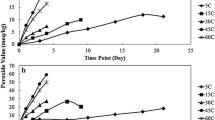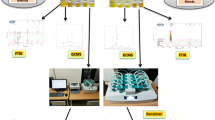Abstract
Flaxseed oil (FO) containing crawfish (Procambarus clarkii) astaxanthin (FOA) was evaluated for lipid oxidation and astaxanthin degradation. The FOA was analyzed for astaxanthin content, free fatty acids (FFA), peroxide value (PV), fatty acid methyl esters (FAMEs) profile, and color. The amount of extractable astaxanthin in the crawfish byproducts was 3.02 mg/100 g of crawfish byproducts. FOA and FO had a similar alpha-linolenic acid (ALA) content (on a weight% basis). The FO was lighter and more yellow in color than FOA. The oxidation rate of FOA was lower than that of FO. When FO and FOA were heated to 30 °C, both oils exhibited minimal lipid oxidation with increasing heating time, whereas FO, when heated to 40, 50, 60 °C, had a higher lipid oxidation rate than FOA with increasing the heating time from 0 to 4 h. Astaxanthin was an effective antioxidant agent in FO when it was heated from 30 to 60 °C. The degradation of astaxanthin in FOA could be described by first order reaction kinetics. Astaxanthin was stable in flaxseed oil at 30 and 40 °C, while its stability decreased significantly at 50 and 60 °C. The rate of astaxanthin degradation in FOA was significantly influenced by temperature.






Similar content being viewed by others
References
Chen HM, Meyers SP (1982) Extraction of astaxanthin pigment from crawfish waste using a soy oil process. J Food Sci 47:892–896
Shahidi F, Synowiecki J (1991) Isolation and characterization of nutrients and value-added products from snow crab (Chinoecetes opilio) and shrimp (Pandalus borealis) processing discards. J Agric Food Chem 39:1527–1532
Miki W (1991) Biological functions and activities of animal carotenoids. Pure Appl Chem 63:141–146
Tanaka T, Morishita Y, Suzui M, Kojima T, Okumura A, Mori H (1994) Chemoprevention of mouse urinary-bladder carcinogenesis by the naturally-occurring carotenoid astaxanthin. Carcinogenesis 15:15–19
Jyonouchi H, Sun S, Iijima K, Gross MD (2000) Antitumor activity of astaxanthin and its mode of action. Nutr Cancer 36:59–65
Tanaka T, Kawamori T, Ohnishi M, Makita H, Mori H, Satoh K, Hara A (1995) Suppression of azoxymethane-induced rat colon carcinogenesis by dietary administration of naturally occurring xanthophylls astaxanthin and canthaxanthin during the postinitiation phase. Carcinogenesis 16:2957–2963
Snodderly DM (1995) Evidence for protection against age-related macular degeneration by carotenoids and antioxidant vitamins. Am J Clin Nutr 62:S1448–S1461
Meyers SP (1994) Developments in world aquaculture, feed formulations, and role of carotenoids. Pure Appl Chem 66:1069–1076
Delgado-Vargas F, Paredes-Lopez O (2003) Natural colorants for food and nutraceutical uses. CRC Press, Boca Raton, FL
Tzang BS, Yang SF, Fu SG, Yang HC, Sun HL, Chen YC (2009) Effects of dietary flaxseed oil on cholesterol metabolism of hamsters. Food Chem 114:1450–1455
Aidos I, Lourenco S, Van der Padt A, Luten JB, Boom RM (2002) Stability of crude herring oil produced from fresh byproducts: influence of temperature during storage. J Food Sci 67:3314–3320
Sachindra NM, Mahendrakar NS (2005) Process optimization for extraction of carotenoids from shrimp waste with vegetable oils. Bioresour Technol 96:1195–1200
Chen HM, Meyers SP (1984) A rapid quantitative method for determination of astaxanthin pigment concentration in oil extracts. J Am Oil Chem Soc 61:1045–1047
Association of official analytical chemists, Helrich K (1990) Official methods of analysis of the association of official analytical chemists. The Association of Official Analytical Chemists, Arlington
Maxwell RJ, Marmer WN (1983) Systematic protocol for the accumulation of fatty-acid data from multiple tissue samples–tissue handling, lipid extraction and class separation, and capillary gas-chromatographic analysis. Lipids 18:453–459
Niamnuy C, Devahastin S, Soponronnarit S, Raghavan GSV (2008) Kinetics of astaxanthin degradation and color changes of dried shrimp during storage. J Food Eng 87:591–600
Meyers SP, Bligh D (1981) Characterization of astaxanthin pigments from heat-processed crawfish waste. J Agric Food Chem 29:505–508
De Holanda HD, Netto FM (2006) Recovery of components from shrimp (Xiphopenaeus kroyeri) processing waste by enzymatic hydrolysis. J Food Sci 71:298–303
Saito A, Regier LW (1971) Pigmentation of brook trout (Salvelinus fontinalis) by feeding dried crustacean waste. J Fish Res Board Can 28:509–512
Bera D, Lahiri D, Nag A (2006) Studies on a natural antioxidant for stabilization of edible oil and comparison with synthetic antioxidants. J Food Eng 74:542–545
Choe E, Min DB (2005) Chemistry and reactions of reactive oxygen species in foods. J Food Sci 70:142–159
Naz S, Sheikh H, Siddiqi R, Sayeed SA (2004) Oxidative stability of olive, corn and soybean oil under different conditions. Food Chem 88:253–259
Shyamala BN, Gupta S, Lakshmi AJ, Prakash J (2005) Leafy vegetable extracts–antioxidant activity and effect on storage stability of heated oils. Innov Food Sci Emerg 6:239–245
Adegoke GO, Kumar MV, Krishna AGG, Varadaraj MC, Sambaiah K, Lokesh BR (1998) Antioxidants and lipid oxidation in foods–a critical appraisal. J Food Sci Tech Mys 35:283–298
Levenspiel O (1999) Chemical reaction engineering. Wiley, New York
Rao AR, Sarada R, Ravishankar GA (2007) Stabilization of astaxanthin in edible oils and its use as an antioxidant. J Sci Food Agric 87:957–965
Dhuique-Mayer C, Tbatou M, Carail M, Caris-Veyrat C, Dornier M, Amiot MJ (2007) Thermal degradation of antioxidant micronutrients in Citrus juice: kinetics and newly formed compounds. J Agric Food Chem 55:4209–4216
Author information
Authors and Affiliations
Corresponding author
Additional information
Approved for publication by the director of the Louisiana Agricultural Experimental Station as Manuscript number 2009-232-3971.
About this article
Cite this article
Pu, J., Sathivel, S. Kinetics of Lipid Oxidation and Degradation of Flaxseed Oil Containing Crawfish (Procambarus clarkii) Astaxanthin. J Am Oil Chem Soc 88, 595–601 (2011). https://doi.org/10.1007/s11746-010-1713-8
Received:
Revised:
Accepted:
Published:
Issue Date:
DOI: https://doi.org/10.1007/s11746-010-1713-8




